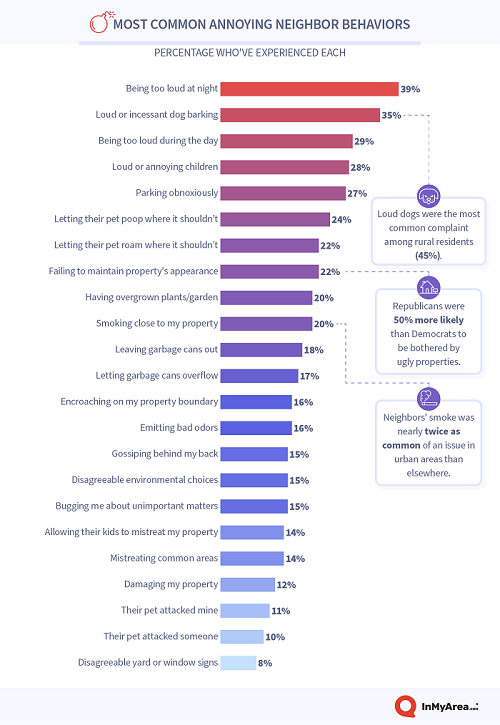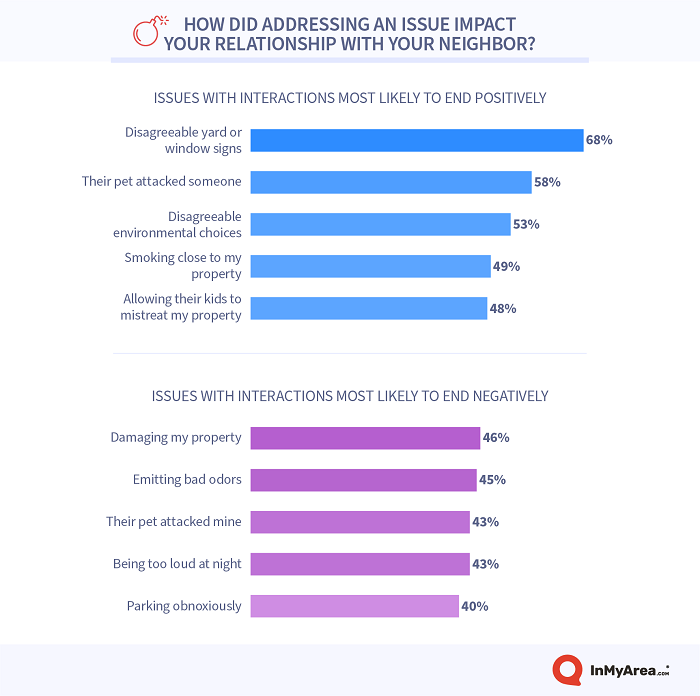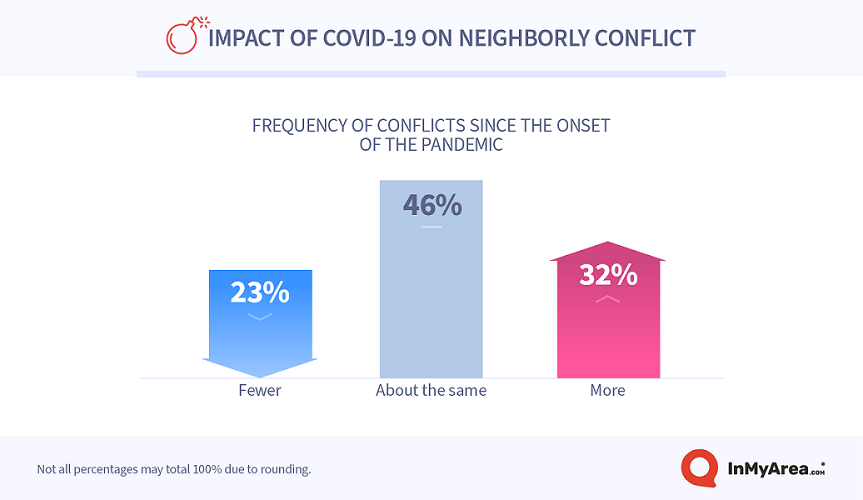Have you ever dealt with a particularly annoying neighbor? For many, moving to a new place already comes with its own anxieties – and realizing you live next to someone inconsiderate can really dampen spirits. And with the pandemic forcing many of us to stay home, a great neighbor goes a long way.
To figure out what kind of neighborly annoyances bother us the most, we combined detailed analysis of Google search trends over the past two years with an extensive survey of over 1,000 Americans – many of who expressed their grievances over problems including noise, smoking, and pet-related issues.
Key Takeaways
- Across the U.S., regardless of almost any geographical or demographic factors, the top complaints people have about their neighbors revolve around noise. Even in rural areas, these concerns top the charts.
- Respectfully confronting your neighbors about their disagreeable or problematic yard signs, annoying smoking habits, or disagreeable environmental choices are more likely to have a positive impact than a negative one.
- Men were less likely than women to confront issues with neighbors head-on and were more likely to involve the authorities or a landlord in the dispute.
A National Look at Annoying Neighbors
Picture this: It’s late at night. You climb into bed, shut your eyes, and proceed to be kept awake all night by the incessant barks of a neighbor’s agitated dog. The next morning, you grab your laptop, yawn determinedly, and furiously type “how to get neighbor’s dog to stop barking” into Google. According to search volume data provided by SEMrush, this experience is all too common. In fact, complaints about a neighbor’s loud dog are the most commonly searched neighbor-related complaints in the U.S., nationally and in every state. Complaints about easement issues and loud music were the second- and third-most-common searches.
Annoying Neighbors: The Most Common Complaints
While search volume data detailing complaints about neighbors provides a valuable insight into the things that bother Americans the most, we wanted to dig deeper into specific gripes. How are Americans choosing to address issues with their neighbors, and how does confronting the issue impact relationships among neighbors?
Unsurprisingly, respondents to the national-level survey typically selected multiple issues with neighbors. On average, they reported having four to five different problems with their neighbors – ranging from loud pets to parking debacles.

But these actions only help explain a small piece of the puzzle. More importantly, what kind of role do demographics play? Are people more likely to become irritable if they have distinct characteristics? According to the survey, there are several key traits which play a massive part in how we perceive our neighbors.
Of all characteristics, pet ownership and parenthood were the most impactful. Those with at least one child or pet typically had around 25% more complaints than other respondents – perhaps reflecting people’s sensitivities to overprotecting their kids and animals.
Generationally speaking, millennials had slightly more complaints, on average, than baby boomers or Gen Xers. Republicans similarly had about 13% more issues on average than Democrats.
Living spaces also played a fairly big role in how neighbors perceived one another. Those living in larger spaces, such as duplexes or town houses, reported more annoyances than those in apartments or single-family houses.
With all of these issues, how often do people seriously consider moving because of annoying neighbors? According to our survey, nearly 4 in 10 Americans had moved to escape neighbors – with roughly 21% having seriously considered it. While many often look at location or safety when picking a new home, it seems people underestimate the kind of impact bad neighbors can have on their experience.
And given the likelihood of encountering an awful neighbor, people need to take these factors into more serious consideration.
Does Addressing Problems Improve Neighbor Relationships?
Clearly, neighbors are facing a relationship crisis that needs fixing – but does speaking and addressing the problem actually help solve it? According to the survey, it really depends on the situation – with demographics, again, playing a large role in conflict management.
Yet, when considering how to resolve an issue, respondents primarily dealt with their neighbors directly – with nearly 7 in 10 opting to address the situation with them, for the less confrontational, about 3 in 10 deferred to a higher authority, such as a landlord.

But these responses, while informative, are influenced greatly by demographics. For example, men were more likely than women to appeal to authority – with many involving their landlord, the police, or city code enforcement. Some even deferred to less powerful bodies – including their homeowner association.
Additionally, men were about 50% more likely to write a note to their issue about the situation, while women were 11% more likely to confront their neighbors directly.
While millennials complained more than older generations, on average, they also reported it less – with only 6 in 10 millennials confronting their neighbor, compared to 7 in 10 Gen Xers and baby boomers. As a means of resolving neighbor disputes, millennials instead were more likely to reach out to police or their landlord.
Other than demographics, the problem itself also impacted the outcome of a confrontation. Disagreeable or distasteful yard signs resulted in a much more positive outcome. On the other hand, broaching more serious issues – including property damage – typically harmed respondents’ perceptions of their neighbors.
Although these responses vary, they reveal that neighbors must figure out the best course of action whenever they run into a problem, as it can have serious consequences on their relationships.
The Impact of COVID-19 on Neighbor Relationships
COVID-19 exacerbated mental health issues, anxiety, and irritability. In fact, nearly 4 in 10 adults in the U.S. – a 30% jump – reported symptoms of anxiety disorder. Moreover, staying home through the pandemic also meant getting closer with your neighbors – for better or worse.

In line with this rise in anxiety came an increase in irritation – with 1 in 3 respondents noting they had been more annoyed with their neighbors since the pandemic started. Yet, in that same vein, 2 in 10 reported having less conflict – perhaps reflecting some of the togetherness the pandemic fostered.
Despite these changes, nearly 5 in 10 reported having the same number of issues – indicating neither a positive nor negative impact on their relationships with neighbors.
Interestingly, pets seemed to play a much larger role in neighborly problems. As established, the pandemic resulted in somewhat of a fur baby boom, with roughly a quarter of pet owners getting their companion post-COVID.
And while pets have helped many cope with the stress of the pandemic, they have equally brought some challenges – with many owners observing behavioral changes. Perhaps this helps explain why a little over 5 in 10 respondents claimed their neighbor’s pet had attacked someone.
Conclusion
Having now analyzed the survey responses, one thing remains certain: There are a ton of factors that impact our perceptions of neighbors – from political identities to pet ownership. These conflicts reveal how addressing and confronting the situation typically removes the annoyance – sometimes to the detriment of their relationship with their neighbor. But sitting back and doing nothing will only make the situation worse – and in a few rare cases, violent – so we must take time to do the neighborly thing and openly talk about our problems.
Our Data
Search trend data used to perform the analysis in the first portion of this study was provided courtesy of SEMrush and represents the volume of search requests on a given keyword or keyphrase from 2019 through 2021.
Survey data used in this study came from a survey of 1,012 American adults. 573 were millennials, 251 were from Gen X, and 128 were baby boomers. The remaining 60 respondents were from Gen Z or older generations. 534 were men, 465 were women, and 13 had other genders or declined to share their gender. All demographic breakdowns were limited to groups with a sample size of over 120. The main limitation of this survey is the reliance on self-report, which is faced with several issues including, but not limited to, the following: attribution, exaggeration, telescoping, and recency bias.

